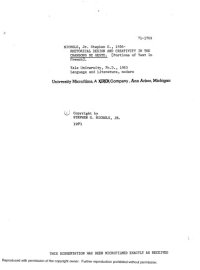
Ebook: Rhetorical design and creativity in the chansons de geste
Author: Stephen G. Nichols Jr.
- Genre: Literature
- Year: 1963
- Publisher: Yale University
- City: New Haven
- Language: English
- pdf
The purpose of this dissertation was two-fold: to show that it would be possible to discern and describe individual stylistic traits in the Old French epics, even though their diction is highly traditionalized, and to demonstrate how these stylistic studies could be used to expose the dixiei-tut stages in the evolution of the literary aesthetic of the genre. This in turn suggested the possibility of a genre description taking into account the interrelations of the works themselves at various levels. Such a genre description proved desirable because it is based on a cumulative image of the works, against which the least and the best could be measured objectively.
Accordingly, Chapters One through Four examine very closely three chansons de geste in which very definite stylistic patterns, through which can be determined the whole structure of the work, are found. These stylistic patterns are invariably based on linguistic resources which are common to the other chansons de geste; they are not unique to the particular epic under observation. It is only in the way in which the device is used in a particular epic that it becomes an individualized stylistic pattern. The fact that the resources are common to the whole tradition offers a measure of control for the observations which would otherwise be lacking. As it is, we can see how differently one epic employs a certain device, since we can find that device used in other epics.
The results of the first four chapters were sufficiently enlightening to permit a formulation, in Chapter live, of a new hypothesis regarding the mode of existence of the chansons de geste: a two-level tradition of creative works and re-creative works. Such a tradition would explain the disparity between the tremen dously imaginative works and the pale imitations of them which do not seem to belong either technically or imaginatively to the sphere of the former.
Chapter Six provides an opportunity to review the findings of the first five chapters and to suggest the most fruitful way for literary theory, criticism, and history to be employed in studying the genre.
Accordingly, Chapters One through Four examine very closely three chansons de geste in which very definite stylistic patterns, through which can be determined the whole structure of the work, are found. These stylistic patterns are invariably based on linguistic resources which are common to the other chansons de geste; they are not unique to the particular epic under observation. It is only in the way in which the device is used in a particular epic that it becomes an individualized stylistic pattern. The fact that the resources are common to the whole tradition offers a measure of control for the observations which would otherwise be lacking. As it is, we can see how differently one epic employs a certain device, since we can find that device used in other epics.
The results of the first four chapters were sufficiently enlightening to permit a formulation, in Chapter live, of a new hypothesis regarding the mode of existence of the chansons de geste: a two-level tradition of creative works and re-creative works. Such a tradition would explain the disparity between the tremen dously imaginative works and the pale imitations of them which do not seem to belong either technically or imaginatively to the sphere of the former.
Chapter Six provides an opportunity to review the findings of the first five chapters and to suggest the most fruitful way for literary theory, criticism, and history to be employed in studying the genre.
Download the book Rhetorical design and creativity in the chansons de geste for free or read online
Continue reading on any device:

Last viewed books
Related books
{related-news}
Comments (0)